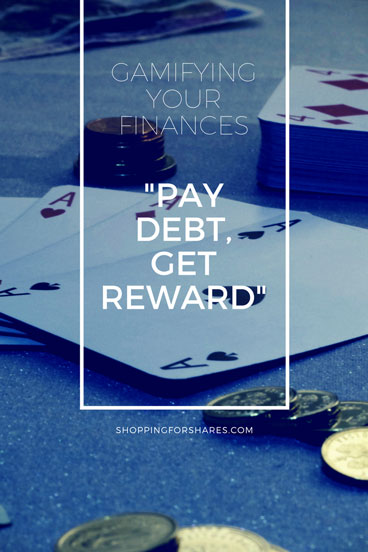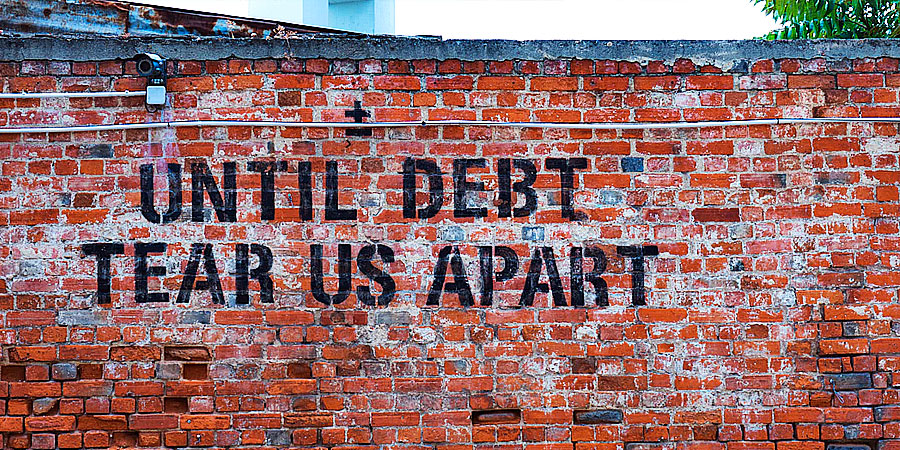 There are lots of different ways to pay off your debts. In this previous post, I went through the steps of first figuring out how much you owe, and then working out which method of paying it off that you preferred.
There are lots of different ways to pay off your debts. In this previous post, I went through the steps of first figuring out how much you owe, and then working out which method of paying it off that you preferred.
All important and helpful information, but not exactly inspiring.
So now it’s time to go deeper and talk about ways not only to find extra money to pay off that debt faster but also make it super motivating and fun too.
Er, fun?
Stay with me.
It’s time we played a game.
Gamify paying off your debts
Have you ever played a game, perhaps on your phone, or your kid’s console, that you became obsessed with? You couldn’t put down the controller, or stop repeating a certain level because if you just got to the next step, you’d gain powers or points or gems or … it didn’t matter what it was. All that mattered was that you did it. That you passed the level.
Those games are addictive because with each achievement your brain releases a small amount of dopamine. Dopamine is a pleasure chemical that’s wicked powerful for increasing motivation.
It can also lead you to do things that aren’t so good for you too, like gambling or drugs. It’s a hard high to break from.
Numerous studies say that we can use this chemical to our benefit, rather than our detriment. We can replace the bad habits with another that gives equal pleasure.
That’s where gamification theory comes in. It’s turning things we want to do in real life into a game. Creating levels and goals for reaching milestones where the theory goes, we are rewarded not only for ‘points’ but also that same dopamine rush.
Gamify your Finances
Paid $100 off your credit card? Bam! You just reached the next level, my friend.
We do this already in some capacity. Completed a gym workout? Go treat yourself to a new t-shirt. Happy chemical rush (and a new top).
The science still is unclear whether gamification can completely change your motivation the same way it seems to with computer games. Some studies say it does, others say it has no noticeable effect.
But what is agreed is that giving yourself rewards is something we already do and it’s worth using to create new healthier habits.
Like paying off unwanted debts.
Points System
The points system is a very simple version of gamification. The basic premise is that you get one point for every dollar that you pay off your debt, and you lose a point if you add to the debt.
Your goal is to reach certain points levels.
100 points and you can treat yourself to a small inexpensive (or free) reward. Something like a luxurious bubble bath, or renting the $0.99 movie of the week from iTunes (every so often they have one that’s decent).
1000 points and you spend the day at the beach with your family/friends, or visit an art gallery, or watch a new band at the local hangout.
The point rewards that you choose should be things that are motivating and meaningful to you.
Make a list of everything you’ve always wanted to do but say you never have time for. Things that would make you happy and feel fulfilled. They can cost small amounts, but nothing that would create more debt.
Allocate different points levels to each of those rewards. Bingo! You’ve just created your first game to paying off debt.
Go accumulate those points. The game starts now.
Don’t Break the Chain
Don’t Break the Chain is a method that was made famous by comedian Jerry Seinfeld. In his version, he would make sure he wrote something every single day. It might have been a joke or a funny observation. Something that he might be able to use in his stand up routines.
Every single day he’d mark his calendar on the days he completed his task. His goal: never miss a day, don’t break the chain.
You can apply the same principle to your own life for anything you like, including paying off your debts.
So instead of writing something every day, you would change your chain to doing something every week towards becoming debt free.
Every single week you need to do something extra, on top of what you’re already doing, that will take you a step closer to becoming debt free.
That could be adding additional money to one of your credit cards. Selling something you own to use that money as an extra loan payment. Taking up a side hustle for the sole purpose of using that income to pay off that debt even faster. Or even as simple as choosing not to buy something that you really want until you can afford it.
Every single week you make a commitment to doing one extra thing toward becoming debt free.
Create a weekly calendar. Those weeks will add up fast and you’ll see real progress. Mark each week that you do something to help you reach your goal. And don’t break the chain.
Reward yourself for reaching milestones
Okay, so I’ve convinced you that making paying off debt fun, and it will help you to become more motivated.
Giving yourself points or goals or challenges is all great, but what sort of rewards are you going to give yourself?
Different rewards work for different people, so you’ll need to brainstorm what kinds of rewards will work for you.
I personally prefer experience type rewards over stuff. I find memories and enjoying life can be more motivating than objects. You might be the same, or different.
Here are some ideas to get you started:
- Spend the night binge watching your favorite Netflix show complete with wine and popcorn.
- Relax in a bubble bath complete with candles and soft music.
- Make a coffee date with that friend that you haven’t see in months and spend the afternoon catching up on each other’s lives.
- Take the kids on a picnic to the closest beach/farm/playground.
- Snuggle in bed with toasted buttery croissants, hot coffee, and a new book.
- Sip cocktails at the edge of a riverbank at sunset.
How to continue the Journey to becoming Debt Free
The road to becoming debt free should be a journey. Sometimes that journey will take a long time, other times it’ll be a short stroll around the block. But the destination at the end is sweet and free and something we should all strive for.
From here there are a few rules to live by.
Quit creating more Debt
The debt stops here.
You know how much stress and struggle it is when you have debts and bills piling up. It’s not fun. I’d prefer to live a simpler life, a life where I can live within my means, but still brings joy.
Make a commitment to yourself not to add any more debt to your life. I’m obviously talking about loans and credit cards here, not mortgages. Having a house can provide security that’s important to many of you.
I mean the bad debts, the ones that eat at your happiness because you spend the night worrying about how you’re going to pay for them.
You’ve come this far and you’ve gained control over your spending. You have a budget. You know how to do this now.
For here on it’s your goal to not buy anything you can’t afford. If you want it that badly, then save for it. Don’t believe in instant gratification, working towards something will give it that much more meaning when you do get it.
Consider a 0% Balance Transfer
Most banks offer credit cards where you can transfer the balance of your current card without interest for a specific term.
The term usually varies, but most often is for one year.
This can be a great way to give yourself a break from the interest and help pay down the balance on your old card quicker.
However, if you want to use this strategy you need to be aware of some of the catches that this offer comes with.
Firstly, the credit card will usually attract a high-interest rate once the term is up. Make sure you check what that interest rate will be before signing up.
Secondly, the 0% interest only applies to the balance that you transfer over, not for any extra purchases that you make with the new card.
This strategy can be used successfully, but only if you think that you can pay the full balance within the term that includes the 0% interest. If that’s not the case, a better strategy would be to transfer the balance to a low-interest master card instead.
Try negotiating a lower interest rate
If you want to keep your current card but you’re struggling to get the balance down, it can be a good idea to ring your bank to see if they’ll be able to offer a lower interest rate.
Before you call, check out the website for their current advertised card rates. They change up their interest rates regularly and its always worth checking if their credit card interest rates are the same as what you’re currently on.
You’ve got a greater chance of getting an interest rate reduction if the current rates are lower than what you’re on now. It also helps if you’ve been a regular customer of the bank over many years.
It’s scary to call, I know, but what’s the worst that can happen? They say they can’t help, then no big deal. If they can help and lower your interest rate, even just a few points, then it was worth finding out.
What about a Debt Consolidation Loan?
If your debts are considerable, and even after all your pay down strategies are in place and you’re not seeing any progress, you might want to consider a debt consolidation loan.
Refinancing your debts into the one loan is something that you need to be serious about before going through with. There are risks to it and it isn’t the right decision for everyone.
Often there are conditions attached to those loans and they still have high-interest rates. Do your research and find a reputable debt consolidation company or see if your current bank offers the option, and read all the fine print before signing anything.
It’s a big decision and only one you should take if you’ve tried everything else.
Give paying off your current debts more time and energy before jumping into another debt.
Pay Credit Card Purchases the Same Day/Week you Make Them
I use my credit card multiple times a week.
To ensure that I’m never slugged with any interest payments, I make sure to keep my balance at zero.
When I make a purchase, once that transaction comes up on my credit card statement, I transfer the money from my regular account to my credit card. Immediately. Right away. Or at least, that night when I have a few minutes to myself.
Lots and lots of small transfers. I don’t wait until I get the end of month statement and do one lump sum. I’m proactive about it and start paying the amounts as soon as they appear. $50 here, $15 there.
Since the transactions always show up within a day or two, it’s also a good way of remembering what you purchased. There were times before I started doing this that I’d wonder what a transaction was because the store name wasn’t familiar (sometimes purchases come up under parent company names rather than the store name). If you’re constantly checking in, you tend to remember where you spent that $23.85 on Monday.
Check your balance regularly. Every night if possible, to allow yourself to stay on track of where you are and keep on top of your credit card usage.
Make it your mission to get your card to zero balance and then keep it there by paying for purchases as soon as possible.
No one wants to pay the bank extra money you don’t have to. Interest sucks and keeps you from getting ahead.
Keep up those Payments
Keep up the regular payments. Seeing those numbers on your debts start to get smaller means you’re making progress.
Eventually, your debt will be gone. You achieve that which you focus on.
Should you cut your credit cards up?
I’ve heard it before. Cut up your cards so you won’t be tempted to use them. Freeze them in a chunk of ice, if you still want it after the ice has thawed then it was a legitimate want.
I disagree with that. Cutting up credit cards is the adult equivalent of taking a child’s toy away when they’re being naughty. It doesn’t teach us anything, just makes us resentful.
It can also be detrimental to your credit score.
It might work in the short term, but we live in a world where buying on credit is a reality. If it’s that much of a problem for you, then consider a debit card instead.
I won’t be cutting my credit cards up.
Used in a responsible manner, credit cards are not the enemy. They can be useful, and in today’s world, necessary.
You just need to take the control back. Debt can be managed with education and a solid plan of attack. Not a solid block of ice with your card inside.
And I know you can do it. You’ve already taken the beginning steps.
You’ve got this.
From the author
Did you find this article useful? It’s actually part of the first draft of a general finance book I’m writing. I’ve decided to blog the book (that is, write the first draft of the entire book on this blog as I go.)
The blog posts might not be in order as I skip around different sections of the book, and not everything I write may end up in print. However, it’s a good strong base for what you’ll find inside.
That means you can watch me write it, and even read the book for free (a few thousand words at a time) if you like.
Or if you want to get notified when I publish it, you can sign up to my email list below (I’m only sending out emails once the book is done and I don’t know how long that will be).
Until the next post, happy reading.
Tracey 🙂
[mailerlite_form form_id=1]


